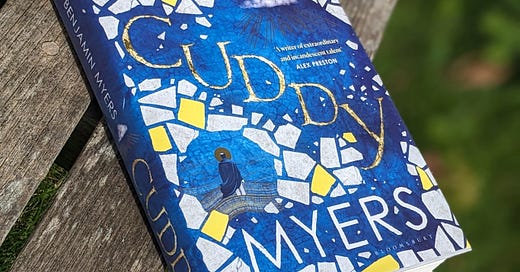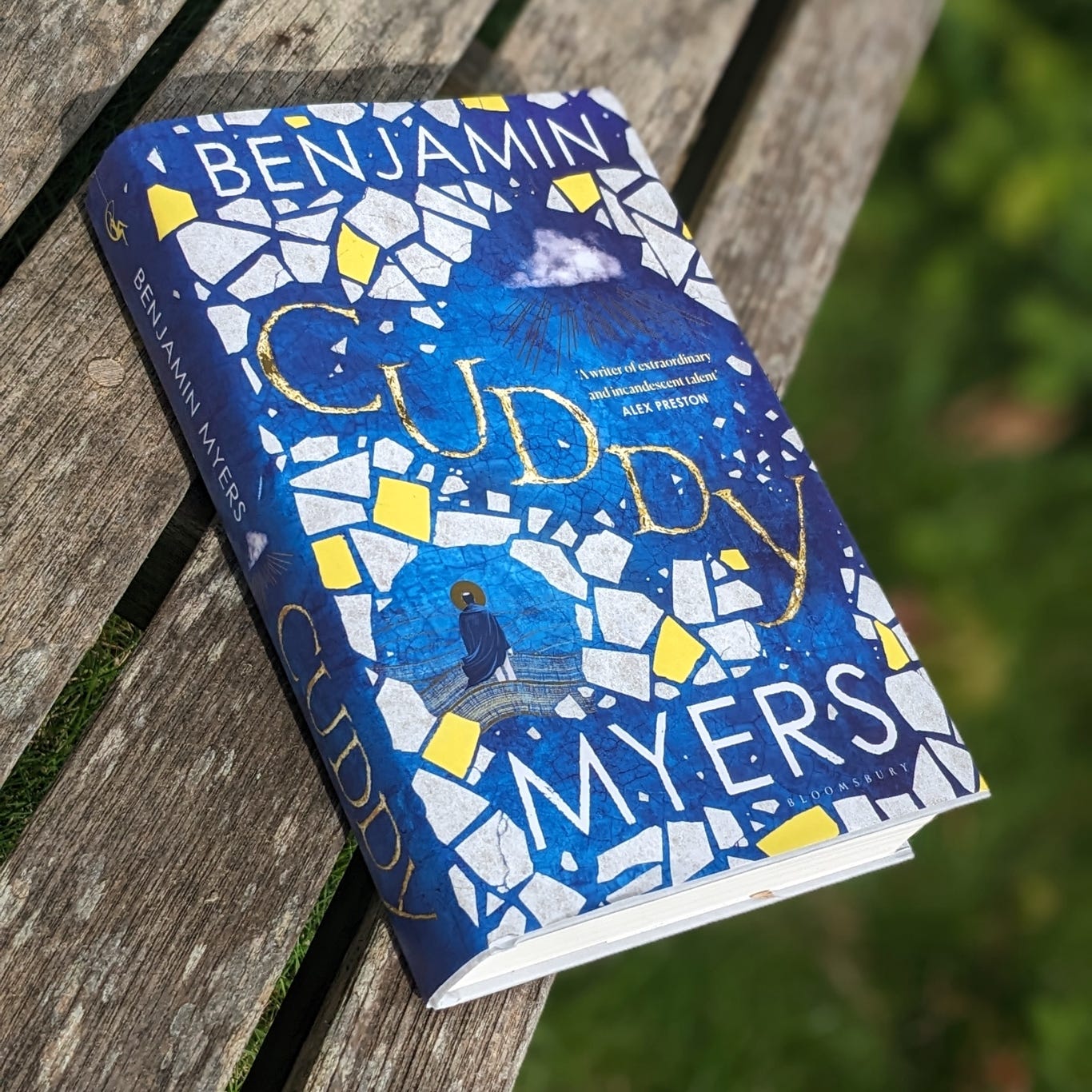The Oldest Story and the Saintly Seven
Friday Fireside | #1 | A throwaway line in Benjamin Myers' new novel sent me 100,000 years into our past and 444 light years into space.
I am currently reading Cuddy, the latest novel by Benjamin Myers. It is an extraordinary genre-bending book, combining fact and fiction, poetry and prose, drama and diaries, with primary and secondary sources, to tell a tale that spans 14 centuries: from a 7th-century saint to 21st-century Durham.
In the opening pages, seven monks wander the wild North bearing the body of their beloved Saint Cuthbert.
In life, he was the animal-loving Bishop of Lindisfarne – the holy “island of the tides” that became the first unhappy target of Viking raids in 793. In death, the incorruptible saint is on the run from those same “pagan wolves”, in search of his final resting place.
But there’s a lot of waiting around and getting lost while the monks argue. The young cook Ediva who accompanies them thinks there are other reasons for the delay:
Once we waited
at a fork in a track
by an abandoned byre
for fourteen moons
as reasonings raged,
though I’d wager the delay
had much to do with the nearby farming family
whose father had sired seven fine strong daughters
– seven, of course, being a holy number –
Seven monks. Seven sisters. Seven’s the magic number.
It’s the world’s favourite and it’s the bread and butter of myth and religion: seven days of creation, seven sleepers and seven deadly sins, not forgetting the seven priests blowing seven trumpets for seven days to bring down the walls of Jericho.
And then there’s the seventh son of the seventh son. In Irish tradition, these men had miraculous healing powers. One of the most famous examples was Valentine Greatrakes “The Stroker” who toured England in 1666 and even demonstrated his gift to Charles II. The king was not convinced but many others were.
The “seven fine daughters” in Cuddy made me think of Seven Sisters, a district of north London, and Seven Sisters Road, where I used to live.
Those sisters were originally seven elm trees that stood on Page Green Common until 1955. Years later five families of seven sisters planted hornbeam trees to replace the long-gone elms. Hornbeam. Named for their horn-like hardness, their American cousins are sometimes called ironwood or musclewood.
Local maps of north London show those seven elms standing as far back as 1619.
But the stories of the seven sisters are much older.
Perhaps even 100,000 years older.
In the night sky, the Pleiades star cluster is known in different cultures as the Seven Sisters. In Greek mythology, they were the divine daughters of the god Titus and the sea nymph Pleione.
The Pleiades were at times companions of the huntress Artemis, as well as nursemaids and teachers of the infant Dionysus, the kid whom we thank for first gathering grapes and making wine.
When the nymphs died, Zeus put them in the sky.
But it wasn’t just the ancient Greeks who saw seven sisters up there.
In the northern Sahara, Tuareg Berbers call them Cat iheḍ ("daughters of the night"). The Wyandot-speaking peoples of North America told of the Singing Maidens, daughters of the Sun and the Moon. In Australia, the Wurundjeri remember the stars as burning coals of the seven Karatgurk sisters – the first to know fire-making.
But here’s the curious thing: there aren’t seven Pleiades.
The 18th-century French astronomer Edme-Sébastien Jeaurat mapped 64 stars. And in fact, there are over a thousand.
But with the naked eye, you’re doing well if you can make out six.
So why seven sisters?
Astrophysicists Ray Norris and Barnaby Norris simulated what the constellation looked like 100,000 years ago. Back then, two of the stars appeared more distinct and our prehistoric ancestors would have clearly seen seven Pleiades in the sky.
What makes this really fascinating is there are several distinct myths about a “lost Pleiad” – in Greek mythology, Merope, glowing fainter than the rest for marrying the mortal Sisyphus instead of a god. Or the Nez Perce tribe of the Pacific Northwest who hides herself from grief and shame when her mortal lover dies.
So could the seven sisters be the oldest story in the world?
Far older than the most ancient written stories, the Mesopotamian Epic of Gilgamesh and the Egyptian Tale of the Shipwrecked Sailor (both around 4,000 years old).
It’s an exciting idea. But also an important one.
It can be easy to dismiss myth and folklore as just stories. Anthropological curiosities. But these fragments of archaic memory give glimpses of real people who weren’t mistaken about what they saw. They were observing a world and a sky different from our own.
There are other examples. The oral history of the Klamath people of Oregon, tells of a battle of gods that destroyed a volcano and buried its deity beneath Crater Lake. Geologists have determined this to be the former volcano, Mount Mazama, that collapsed 7,700 years ago.
Fitzroy Island sits three miles off the coast of northeast Australia. But oral history remembers a time when it was connected to the mainland, almost 10,000 years ago. That’s 400 generations of storytellers.
For me, this is the great attraction of stories. Folded into an incidental detail in Cuddy are many half-forgotten tales, with thousands of years of knowledge buried beneath each word.
All stories are like this. If only we choose to dig.
Welcome to footnotes and tangents!
This is my first newsletter. I will be using this space to share my adventures in reading creatively and curiously, exploring rabbit holes and unbeaten paths leading away from the books at my bedside. I hope you choose to join me.
Next month, I will tell you about two exciting slow read-alongs that I will be running next year and the annotated audiobooks I am creating for Audrey. So stay tuned for that and more footnotes and tangents.
Happy reading,
Simon






I’m from the PNW (my husband grew up on Nez Perce land) but I’d never heard that particular story! I love the way literature prompts these sorts of tangents. It reminds me how connected the world really is.
Great review, the book sounds very interesting. And an excellent newsletter.
Charles II was probably jealous of Valentine Greatrakes because Charles was keen on demonstrating his own ‘royal touch’, to cure his subjects of disease - especially the Kings Evil.